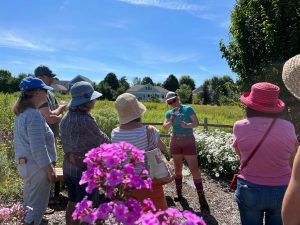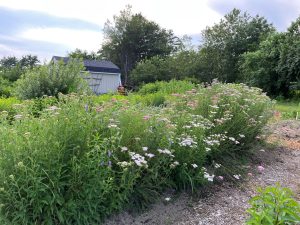Summer 2024 News and Events at Tidewater Farm
Garden Update
 Been hot enough for ya? That fast and hot part of summer has really taken a hold and here we find ourselves in August! How’d that happen? Long days have our vegetable crops, annual flowers and perennials taking off. The monarchs have appeared along with fast growing weeds and hungry deer jumping the fence into the Harvest for Hunger Garden. Water, weed, mulch and repeat! The deer and insect pressure have us scouting daily for pests and using row cover on crops we don’t usually use, and even pulling some things out. We are always learning from the new seasonal challenges, and we try to take time to appreciate the beauty, knowing that there’s so much more to come!
Been hot enough for ya? That fast and hot part of summer has really taken a hold and here we find ourselves in August! How’d that happen? Long days have our vegetable crops, annual flowers and perennials taking off. The monarchs have appeared along with fast growing weeds and hungry deer jumping the fence into the Harvest for Hunger Garden. Water, weed, mulch and repeat! The deer and insect pressure have us scouting daily for pests and using row cover on crops we don’t usually use, and even pulling some things out. We are always learning from the new seasonal challenges, and we try to take time to appreciate the beauty, knowing that there’s so much more to come!

Earlier in the season, we harvested 25 pounds of garlic scapes and had a successful garlic harvest at the end of July, thanks to our Master Gardener Volunteers! Check out images during and after harvest, which included an impressive weeding job of both beds. These beds will be prepared for cover crops and fall carrots. Squash, turnips, cucumbers and greens have been heading to the food pantry and the warm season crops are coming along.

The okra has enjoyed this hot weather, and the first harvest went straight to a community member picking up their weekly supply from Wayside Food Programs. Did you know okra is in the hibiscus (or mallow) family? Once you have seen their beautiful blooms, it’s impossible to forget them.

We are very excited about the completion of a new information kiosk at Tidewater, built by Master Gardener Volunteer John Chance! This upgrade will allow us to highlight our work at Tidewater and Extension and increase engagement with the space, especially when no one is on-site to answer questions.
This is just one example of the diverse skills that the Master Gardener Volunteers share with the gardens!
Upcoming Events at Tidewater
August Field Day
It’s August, but there’s still time to adjust to any challenges you’re facing in the garden! Join us for a Field Day, on Saturday, August 17 from 10:00 a.m. to 12:00 p.m. at Tidewater Farm. Open to the public, no registration required!
Come experience the gardens, learn about Extension’s work, ask gardening questions and participate in hands-on demonstrations focusing around cultivation practices that will keep your garden healthy, productive and looking fresh during the transition from late summer into fall. Participants will take home a gorgeous bouquet of blooms from our market garden.
Drop-in Hours 
Do you have gardening questions? You can drop by the UMaine Gardens at Tidewater Farm in Falmouth on Tuesdays in July and August from 5:00 to 6:00 p.m. to ask your questions. UMaine Extension Horticulture Staff will be on hand to provide assistance and help you troubleshoot garden issues. Staff can answer questions about vegetables, annual flowers, perennials, pest management and more. The extensive gardens at Tidewater Farm can serve as examples of garden spaces that embrace environmentally friendly and sustainable practices, and offer opportunities for hands-on learning and exploration. Enjoy a stroll around the gardens afterwards!
Please note: We will not be accepting any live disease or pest samples during the drop-in hours. Please only bring photos of the disease or pest you have.
The Basics of Composting: From Scraps to Soil
 Interested in turning your food scraps and waste into nourishment for your plants? Join us on Wednesday, September 11, 5:00 to 6:30 p.m. to learn the basics of composting! In this workshop we’ll discuss the advantages of different compost feedstocks, best practices to build and maintain a healthy compost pile, and horticultural uses of finished compost. Participants will also learn about different small-scale composting set-ups, from bins to lobster traps to tumblers. We hope participants will leave the workshop empowered to compost wherever they live, whether it’s a farm, apartment, or community garden.
Interested in turning your food scraps and waste into nourishment for your plants? Join us on Wednesday, September 11, 5:00 to 6:30 p.m. to learn the basics of composting! In this workshop we’ll discuss the advantages of different compost feedstocks, best practices to build and maintain a healthy compost pile, and horticultural uses of finished compost. Participants will also learn about different small-scale composting set-ups, from bins to lobster traps to tumblers. We hope participants will leave the workshop empowered to compost wherever they live, whether it’s a farm, apartment, or community garden.
Registration is required and the program fee is offered on a sliding scale, $5-$15.
Recipe
If you find yourself short on time or too hot to make dilly beans, consider putting those fresh beans in salads.
Green Bean Salad
Salad:
1 pound green beans, cut and steamed
4 large potatoes, diced and boiled
2 scallions, chopped
Dressing:
2 tablespoons oil
2 tablespoons vinegar
1 clove garlic, crushed or ½ tsp. minced garlic
1 small onion, sliced
1/2 teaspoon oregano
Black pepper to taste
Directions:
- Place the beans, potatoes, and scallions in a medium bowl.
- Combine all the dressing ingredients in a jar and shake. Pour over salad. Toss gently to mix the ingredients well.
- Cover the salad and refrigerate for several hours or overnight.
Wildlife Sighting
 Rounding every corner in the gardens, we see chipmunks bounding away and quickly dropping into an escape hole to their burrows. Perhaps a controversial wildlife highlight, let’s consider this enterprising, and dare I say, cute, mammal we coexist with here at Tidewater. Tidewater is mostly populated by the Eastern Chipmunk, with the white belly and distinctive stripes down its back. Often you will be lucky enough to observe their inner cheek pouches full as they scurry to and from their dens, storing a significant cache of food to help them survive through the winter. A chipmunk’s cheek pouches have been measured with a maximum capacity of 70 sunflower seeds, 31 corn kernels, or 12 acorns! The food is pushed into the cheeks through gaps between the lateral teeth.
Rounding every corner in the gardens, we see chipmunks bounding away and quickly dropping into an escape hole to their burrows. Perhaps a controversial wildlife highlight, let’s consider this enterprising, and dare I say, cute, mammal we coexist with here at Tidewater. Tidewater is mostly populated by the Eastern Chipmunk, with the white belly and distinctive stripes down its back. Often you will be lucky enough to observe their inner cheek pouches full as they scurry to and from their dens, storing a significant cache of food to help them survive through the winter. A chipmunk’s cheek pouches have been measured with a maximum capacity of 70 sunflower seeds, 31 corn kernels, or 12 acorns! The food is pushed into the cheeks through gaps between the lateral teeth.
While dismantling a rotted raised bed at Tidewater a few years back, we found a chipmunk food storage cache completely filled with ripe blueberries and tiny strawberries! We left it undisturbed for the night and all the food had been moved the next morning. Eastern chipmunks usually build dens with an upper level for sleep, lined with grass and leaves and lower level dens used for food storage. Chipmunk burrows can be up to 3 feet deep and 30 feet long, but most tunnels are 18–36 inches deep.
Though the burrow holes increase each year, we haven’t had any significant problems with the chipmunks that we share our space with and enjoy their daily antics! Chipmunks play a vital role in seed dispersal of trees, plants, and some fungi. They also eat insects, helping to control these potential pest species for agricultural practices.
References:
